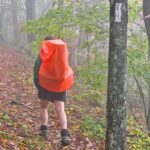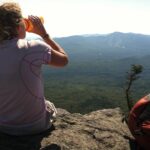Preventing Injuries on the A.T.
Injuries are the number one reason that thru-hikers don’t finish the A.T. While serious injuries are rare on an A.T. hike, less urgent bumps and bruises are relatively common. Many of the injuries sustained while hiking the Trail are due to overuse and overexertion.
The best ways to prevent common injuries while hiking or backpacking are to:
- Listen to your body: If something starts to hurt, stop and fix it or stop for the day. If you begin to feel fatigued or weak, stop and take a snack break and drink some water.
- Physically prepare for your hike by training on similar terrain.
- Test out all gear prior to using it on longer trips.
Visit our Safety page for information about how to prevent and deal with environmental dangers like lightning, hypothermia, and wildlife, and what to do in an emergency if a more serious injury occurs.
If you ever need immediate medical attention on the A.T., call 911.

Pacman Thompson
Common Hiker Injuries
Blisters
Almost all hikers at one point or another face this small but mighty foe. Blisters are so common that they are seen by some hikers as a rite of passage on the A.T. Don’t let this fool you, though! Blisters can become painful, even hike-ending sores.
The best treatment for blisters is prevention!
- Wear comfortable shoes that have been properly broken in. Breaking in new shoes is essential for boots and still helpful for trail runners and lighter footwear. A footwear specialist at most shoe stores can help you pick the right shoe that fits your feet and hiking plans. To break-in new shoes, wear them around the house and on shorter hikes with the socks and insoles you plan to use on your trip.
- Wear the right socks for the job. Using high-quality, breathable socks that are rated for your activity and season makes all the difference. Most A.T. hikers use either all-wool or synthetic socks. On longer hikes, it can be helpful to change your socks each day or even several times a day. Between uses, rinse out the socks and hang them from your pack to dry.
- Take care of hot spots early. A hot spot is a spot on your foot that you’ve just noticed is getting uncomfortable. This is when it’s important to stop and fix the problem or put protection over the spot, like a band aid or moleskin. Waiting even a little longer can cause the hot spot to become a full-on blister.
- Don’t overdo it. Trying to do big mile days before you’re ready can lead to blisters, even if you do everything else right. If you’ve hiked further than normal and your feet start to hurt, swell, or overall feel tight or painful, stop for the day.
If you do get a blister, make sure to keep it clean and covered. Seek medical treatment if you notice signs of infection or the blister gets worse.
Lower Leg & Foot Injuries
While lower leg injuries can happen to anyone on the A.T., we often hear about injuries from hikers who push themselves too far or carry too much. Common lower leg injuries on the A.T. include:
- Shin splints
- Plantar fasciitis
- Tendinitis
- Stress fractures
- Ankle and knee sprains and strains
- Lost/broken toenails
Like blisters, prevention is key! Many of these injuries can be prevented by slowly building up your endurance on the A.T. This also means doing some cardio and strength training before you start your trip. If you start to feel a strain, tenderness, or pain in your feet or legs that doesn’t go away overnight, take that as a sign to slow down or rest.
Other Common Injuries
- Cuts, scrapes, and abrasions
- Cramps and muscle strains
- Shoulder and back pain from carrying a pack
- Chafing
Prevention is once again the best way to keep these injuries at bay. Cuts and scrapes, along with cramps and strains, are more likely to happen due to fatigue, hunger, and dehydration. So, listen to your body and make sure to eat and drink plenty while hiking. Getting properly fitted gear that is not too heavy and wearing comfortable clothing can help prevent back pain and chafing.
Carrying a good first aid kit with Band-Aids and antibiotic ointment is best for treating cuts, scrapes, and chafing. While resting, lowering your pack weight, and stretching can help reduce pain from strains and muscle cramps.
Want to learn more about backcountry injury prevention and treatment?
Taking a Wilderness First Aid (WFA) course is a great way to boost your knowledge, learn the unique challenges that come with emergencies in the backcountry, and learn what goes into a search and rescue. Some A.T. Clubs offer WFA courses or search “Wilderness First Aid course near me.”
ATC Staff Tips
Start Slow
If you’re new to hiking, plan shorter hikes at first (even if you feel like you can do more). For backpackers, this means limiting each day to eight to 10 miles for at least a couple of weeks.
Take a Zero Day
Long distance hikers will find that taking a “zero day” -— a day where you don’t hike any miles –— can do wonders for healing and preventing overuse and stress injuries. Zero days are also great ways to boost your morale and, if you take a zero day in town, a great way to get some extra calorie-rich town food!
Use Trekking Poles
Trekking poles can help prevent knee pain and injuries, along with helping to prevent trips and falls.
Hydrate and Refuel Often
Keep your body fueled with lots of water and food! Eat snacks throughout the day and try to drink at least a liter of water for about every five miles hiked. Drink more on hot days and in rugged terrain to compensate for your body working harder.
A good first aid kit can make all the difference!
First aid kits are among the 10 Essentials of hiking and allow you to treat a range of injuries on the Trail.
What to Carry in your First Aid Kit



